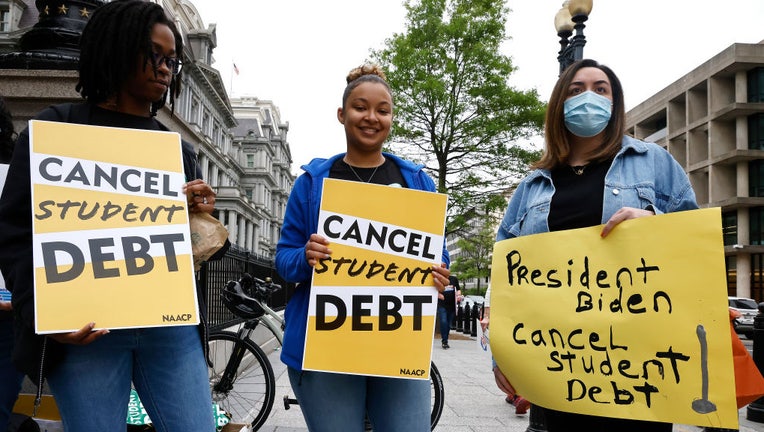Student loan forgiveness eligibility scaled back; here's what you need to know

FILE-Student loan borrowers gather near The White House to tell President Biden to cancel student debt on May 12, 2020 in Washington, DC. (Photo by Paul Morigi/Getty Images for We, The 45 Million)
The Biden administration made adjustments to its student loan forgiveness program on Sept. 29, changing the types of loans eligible for relief and impacting hundreds of thousands of borrowers.
The Department of Education updated its website and said borrowers with federal loans owned by private banks but backed by the government, including the Federal Family Education Loan Program (FFEL) and Perkins loans, will no longer be eligible unless they already consolidated their loans into the government's direct lending program by Sept. 29. The change will reverse eligibility for about 770,000 borrowers.
RELATED: Student loan forgiveness: Biden unveils plan to cancel $10K in student debt
Biden’s student loan relief program commits to forgiving up to $20,000 in federal student loans. The program will cancel $10,000 in student loan debt for those making less than $125,000 or households with less than $250,000 in income. Pell Grant recipients, who typically demonstrate more financial need, will get an additional $10,000 in debt forgiven.
The Department of Education plans to reveal the application for the forgiveness plan in early October, and the agency sent an email to borrowers on Sept. 29 explaining how to prepare to apply. The email explained that applicants do not have to submit any supporting documents.
Adjustments to the forgiveness program were made the same day six Republican-led states sued the Biden administration in an effort to stop its plan to forgive student loan debt for tens of millions of Americans.
The states of Iowa, Kansas, Missouri, Nebraska and South Carolina joined Arkansas in filing the lawsuit claiming Missouri's loan servicer is facing a "number of ongoing financial harms" because of Biden's decision to cancel loans.
Who is eligible for a student loan refund?
When Biden announced the plan to forgive student loan debt, many borrowers who kept making payments during the pandemic while interest was put on pause wondered if they’d made the right choice. But borrowers might be able to see some of that money back in their pockets.
The Department of Education says borrowers who hold eligible federal student loans and have made voluntary payments since March 13, 2020, can get a refund.
RELATED: Student loan forgiveness | What is a Pell grant and how will Biden's program impact recipients?
You will get an automatic refund after you apply for forgiveness if your payments during the pandemic brought your loan balance below the maximum debt relief amount.
For example, if a borrower paid $100 a month for 10 months of the pandemic and their balance is now $8,000, they can apply for forgiveness and get $8,000 canceled, plus a refund of $1,000. That borrower does not need to apply separately for a refund.
If a borrower paid throughout the pandemic and still owes $14,000, they won’t get an automatic refund. They can, however, apply to have $10,000 of the remaining debt erased.
People who completely paid off their loan balance during the pandemic have to apply separately for a refund.
Borrowers who want a specific amount refunded can apply by calling their loan service provider. Right now, refunds are only being done via phone and not through any website or email.
When will my student loans be forgiven?
The Education Department is still on track to unveil the application for the forgiveness plan in early October, and it sent an email to borrowers on Sept. 29 explaining how to prepare to apply.
White House administration official Bharat Ramamurti, deputy director of the National Economic Council, has previously said loan forgiveness will take about four to six weeks after the application is completed.
RELATED: Applications for student loan relief will be available early October, White House says
Filling out the application as soon as possible should clear eligible borrowers to see their loan relief before Dec. 31, when the interest pause will end.
"Borrowers are advised to apply by roughly Nov. 15 in order to receive relief before the payment pause expires on December 31," Ramamurti said.
Applications will still be accepted even after the pause expires on Dec. 31.
What if I still have a balance after the student loan forgiveness is applied?
Borrowers with a remaining loan balance will have their monthly payment recalculated based on their new balance, which could reduce their monthly payment. According to the Department of Education website, your loan servicer will inform you of what your new payment amount is.
Which states tax student loan forgiveness?
Mississippi, North Carolina and Indiana have confirmed that they will consider the Biden student loan forgiveness program a form of taxable income, meaning borrowers will have to report it on their annual income taxes for the year in which the debt is formally discharged. Several other states have confirmed that they are considering this as well, or are waiting to see the final details of the Biden proposal.
The federal government will not tax Biden's loan forgiveness proposal, because the American Rescue Plan suspended taxes on student debt forgiveness through 2025.
RELATED: What does Biden’s student loan forgiveness plan mean for you?
The details of this depend on how state and federal tax collectors treat debt forgiveness.
The IRS and state tax agencies treat student debt forgiveness as any other form of debt discharge. This means that they consider it effectively income for the year in question.
This story was reported from Washington, D.C. The Associated Press contributed to this story.

